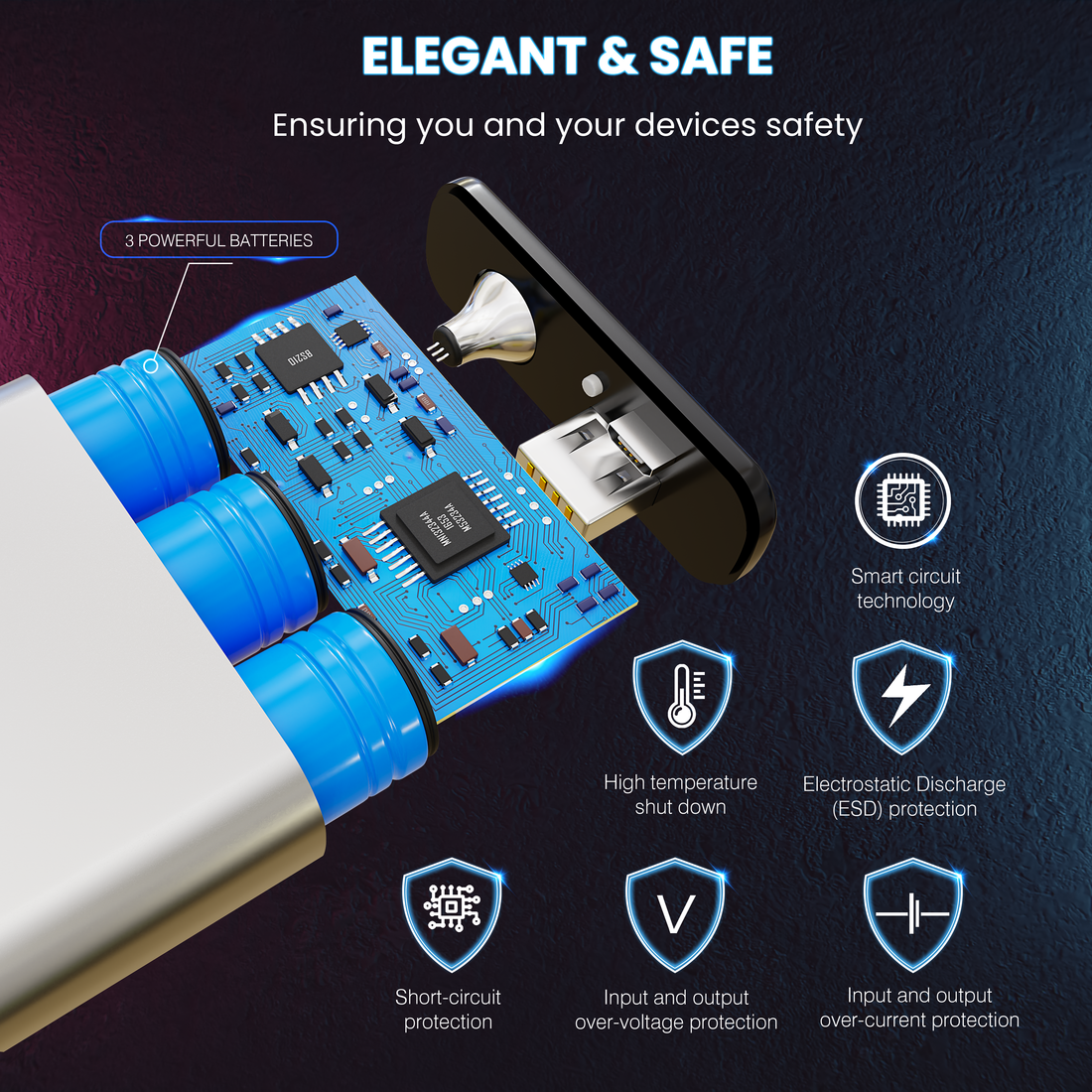Table of Contents
I. Introduction
Power banks are portable charging devices that allow you to charge your electronic devices on-the-go. They have become increasingly popular in recent years due to the growing demand for mobile devices and the need to stay connected at all times. However, what makes power banks truly functional is the type of battery they use, and in most cases, they are powered by lithium-ion batteries.
In this blog post, we will explore the crucial role that lithium-ion batteries play in powering up your devices through power banks. We will discuss the benefits of using these batteries, how they work, and what to look for when purchasing a power bank. By the end of this post, you will have a better understanding of the importance of lithium-ion batteries in power bank functionality, and how to choose the right power bank for your needs.
II. Benefits of Lithium-Ion Batteries in Power Banks
Lithium-ion batteries are the most commonly used type of battery in power banks due to their numerous benefits. Here are some of the benefits of using lithium-ion batteries in power banks:
- A. High Energy Density
Lithium-ion batteries have a high energy density, which means they can store a lot of energy in a small space. This makes them ideal for use in power banks, which need to be small and portable. Compared to other types of batteries, lithium-ion batteries have a higher energy density, which means they can store more energy per unit of weight or volume. This is important because it allows power banks to be more compact and lightweight while still providing a high amount of energy.
- B. Longevity and Durability
Lithium-ion batteries are known for their longevity and durability. They can be recharged hundreds of times before they start to degrade, and they are less likely to leak or suffer from other types of damage. Compared to other types of rechargeable batteries, such as nickel- cadmium and nickel-metal hydride, lithium-ion batteries last longer and can be used for a longer period of time before they need to be replaced.
- C. Low Self-Discharge Rate
Lithium-ion batteries have a low self-discharge rate, which means they can hold their charge for a longer period of time than other types of batteries. This is important for power banks because they are often used infrequently and need to hold their charge for long periods of time. Lithium-ion batteries can hold their charge for several months without being used, making them ideal for use in power banks.
- D. Safe and Environmentally Friendly
Lithium-ion batteries are considered safe and environmentally friendly compared to other types of batteries. They do not contain heavy metals, such as lead or cadmium, which are harmful to the environment. In addition, lithium-ion batteries are less likely to overheat or catch fire, making them safer to use than other types of batteries.
Overall, lithium-ion batteries offer several benefits that make them ideal for use in power banks. They have a high energy density, are long-lasting and durable, have a low self-discharge rate, and are safe and environmentally friendly. These benefits make lithium-ion batteries the most popular choice for powering up your devices on-the-go through power banks.
III. How Lithium-Ion Batteries Work in Power Banks
Lithium-ion batteries work by transferring lithium ions between two electrodes, a positive electrode (cathode) and a negative electrode (anode). When the battery is being charged, lithium ions are moved from the cathode to the anode. When the battery is being discharged, the process is reversed, and the lithium ions move from the anode to the cathode.
- A. Charging Process
When a lithium-ion battery in a power bank is being charged, an external power source is used to transfer energy into the battery. This energy is used to move lithium ions from the cathode to the anode, which creates a charge imbalance between the two electrodes. The charge imbalance results in a potential difference, or voltage, between the two electrodes, which is what allows the battery to store energy.
- B. Discharging Process
When the power bank is being used to charge a device, the opposite process occurs. The lithium ions move from the anode to the cathode, which creates an electric current that can be used to power the device. The process of discharging the battery is what causes the potential difference between the two electrodes to decrease, and when the potential difference reaches a certain point, the battery is considered to be fully discharged.
- C. Voltage and Capacity
The voltage and capacity of a lithium-ion battery are two important factors to consider when using a power bank. The voltage of a battery refers to the potential difference between the two electrodes, and it determines how much energy can be transferred from the battery to the device being charged. The capacity of a battery refers to how much energy the battery can store, and it determines how many times the power bank can charge a device before it needs to be recharged.
It is important to note that the voltage and capacity of a lithium-ion battery can vary depending on the specific battery chemistry and configuration used in the power bank. Some power banks may have multiple lithium-ion batteries that are connected in parallel or in series to increase the voltage or capacity of the power bank.
Overall, understanding how lithium-ion batteries work in power banks is important for choosing the right power bank for your needs. It is important to consider the voltage and capacity of the power bank, as well as the specific battery chemistry and configuration, in order to ensure that the power bank is able to meet your charging needs.
IV. Factors to Consider When Choosing a Power Bank
When choosing a power bank, there are several factors that you should consider to ensure that you get the right one for your needs. Here are some important factors to keep in mind:
- Capacity and Output
The capacity of a power bank refers to how much energy it can store, and it is measured in milliampere hours (mAh). A higher capacity power bank will be able to charge your devices multiple times before it needs to be recharged, but it may also be larger and heavier.
The output of a power bank refers to how much energy it can transfer to your device, and it is measured in amperes (A) or milliamperes (mA). Higher output power banks will be able to charge your devices more quickly, but they may also be more expensive.
- Portability and Design
The portability and design of a power bank are also important factors to consider. If you plan on carrying your power bank with you wherever you go, you will want to choose one that is small and lightweight. Additionally, you may want to consider the design and aesthetics of the power bank, as some models may be more stylish or have additional features like LED lights or built-in cables.
- Safety Features
Safety features are another important consideration when choosing a power bank. Look for power banks that have overcharge protection, which will prevent the battery from being overcharged and potentially causing a fire or explosion. Some power banks may also have built-in circuitry that protects against short circuits, over-discharging, and other hazards.
- Price and Brand
Finally, price and brand are also important factors to consider when choosing a power bank. While you don't necessarily need to buy the most expensive power bank on the market, you should avoid very cheap models, as they may not be reliable or safe. Additionally, look for power banks from reputable brands that have a history of producing high-quality products.
V. Tips for Maintaining Your Power Bank
To ensure that your power bank stays in good condition and lasts as long as possible, it's important to take care of it properly. Here are some tips for maintaining your power bank:
1. Charging and Discharging- Charge your power bank fully before using it for the first time, and make sure to fully charge it after each use.
- Avoid letting your power bank battery drain completely before recharging it, as this can shorten its lifespan.
- If you're not planning to use your power bank for an extended period of time, make sure to recharge it at least once every three months to prevent the battery from degrading.
- Store your power bank in a cool, dry place away from direct sunlight and heat sources.
- Avoid exposing your power bank to extreme temperatures, as this can damage the battery and reduce its lifespan.
- If you're planning to take your power bank with you on a plane, make sure to check the airline's regulations on lithium-ion batteries, as some airlines have restrictions on the size and number of batteries you can bring on board.
By following these tips, you can ensure that your power bank stays in good condition and provides reliable power for your devices whenever you need it. If you are looking for a durable power bank that is ethically made and built to last you can click here
VI. Conclusion
Lithium-ion batteries play a vital role in powering up your devices through power banks. They offer numerous benefits, including high energy density, longevity, and low self-discharge rates. Understanding how lithium-ion batteries work in power banks and what factors to consider when choosing a power bank can help you make informed decisions about which product to buy.
When using a power bank, it's important to take proper care of it by following the tips for maintaining it. This will help ensure that your power bank stays in good condition and lasts as long as possible.
In conclusion, lithium-ion batteries have revolutionized the way we power our devices on-the-go, and power banks have become an essential tool for many people. With the right knowledge and maintenance, you can get the most out of your power bank and keep your devices charged up and ready to go whenever you need them.

